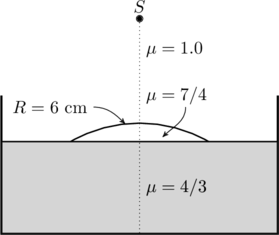JEE Advanced 2011 Paper 2, Question 36
Water (with refractive index ![]() ) in a tank is
) in a tank is ![]() deep. Oil of refractive index
deep. Oil of refractive index ![]() lies on water making a convex surface of radius of curvature
lies on water making a convex surface of radius of curvature ![]() as shown. Consider oil to act as a thin lens. An object ‘
as shown. Consider oil to act as a thin lens. An object ‘![]() ’ is placed
’ is placed ![]() above water surface. The location of its image is at ‘
above water surface. The location of its image is at ‘![]() ’ cm above the bottom of the tank. What is ‘
’ cm above the bottom of the tank. What is ‘![]() ’?
’?

Solution
To find the location of the final image we consider the oil and the water in the tank as a combination of two elements: a lens and a …

